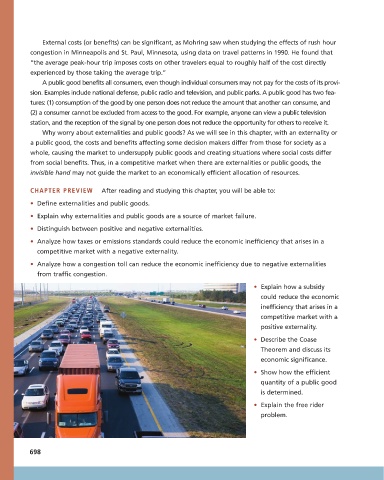Page 724 - Microeconomics, Fourth Edition
P. 724
c17ExternalitiesandPublicGoods.qxd 8/22/10 4:56 AM Page 698
External costs (or benefits) can be significant, as Mohring saw when studying the effects of rush hour
congestion in Minneapolis and St. Paul, Minnesota, using data on travel patterns in 1990. He found that
“the average peak-hour trip imposes costs on other travelers equal to roughly half of the cost directly
experienced by those taking the average trip.”
A public good benefits all consumers, even though individual consumers may not pay for the costs of its provi-
sion. Examples include national defense, public radio and television, and public parks. A public good has two fea-
tures: (1) consumption of the good by one person does not reduce the amount that another can consume, and
(2) a consumer cannot be excluded from access to the good. For example, anyone can view a public television
station, and the reception of the signal by one person does not reduce the opportunity for others to receive it.
Why worry about externalities and public goods? As we will see in this chapter, with an externality or
a public good, the costs and benefits affecting some decision makers differ from those for society as a
whole, causing the market to undersupply public goods and creating situations where social costs differ
from social benefits. Thus, in a competitive market when there are externalities or public goods, the
invisible hand may not guide the market to an economically efficient allocation of resources.
CHAPTER PREVIEW After reading and studying this chapter, you will be able to:
• Define externalities and public goods.
• Explain why externalities and public goods are a source of market failure.
• Distinguish between positive and negative externalities.
• Analyze how taxes or emissions standards could reduce the economic inefficiency that arises in a
competitive market with a negative externality.
• Analyze how a congestion toll can reduce the economic inefficiency due to negative externalities
from traffic congestion.
• Explain how a subsidy
could reduce the economic
inefficiency that arises in a
competitive market with a
positive externality.
• Describe the Coase
Theorem and discuss its
economic significance.
• Show how the efficient
quantity of a public good
is determined.
• Explain the free rider
problem.
698

